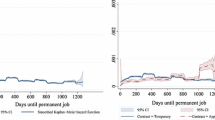Abstract
Dual apprenticeship training is a form of education at the upper secondary level, taking place in vocational school as well as in firms. Therefore, the willingness of firms to offer apprenticeships is a necessity for the functioning of this part of the educational system. Although it is likely that the economic climate has an impact on the firm’s supply of apprenticeships, little is known so far about the impact of the business cycle on the number of apprenticeship programs offered. Using panel-data of Swiss cantons from 1988–2004, we find that the influence of the business cycle is statistically significant, but small in size. Instead, supply of apprenticeship programs is driven to a much greater extent by demographic change.
Similar content being viewed by others
References
Askilden, J. E. & Nilsen, O. A. (2005). Apprentices and young workers: A study of the Norwegian youth labour market. Scottish Journal of Political Economy, 52 (1), 1–17.
Bassanini, A., Booth, A., Brunello, G., De Paola, M. & Leuven, E. (2007). Education and training in Europe. In Brunello, G., Garibaldi, P. & Wasmer, E. (Eds.) Workplace Training in Europe. Oxford: Oxford University Press.
Bassanini, A. & Brunello, G. (2007). Barriers to entry, deregulation and workplace training. IZA Discussion Papers No. 2746.
Bilginsoy, C. (2003). The hazards of training: Attrition and retention in construction industry apprenticeship programs. Industrial and Labor Relations Review, 57 (1), 54–67.
Blatter, M., Muehlemann, S. & Schenker, S. (2008). The costs of hiring skilled workers. Economics of Education Working Paper Series No. 15.
Brunello, G. (2009). The effect of economic downturns on apprenticeships and initial workplace training: A review of the evidence. Paris: OECD.
Brunello, G. & Medio, A. (2001). An explanation of international differences in education and workplace training. European Economic Review, 45 (2), 307–322.
Dietrich, H. & Gerner, H.-D. (2007). The determinants of apprenticeship training with particular reference to business expectations. Zeitschrift für ArbeitsmarktForschung; Journal for Labour Market Research, 40 (2/3), 221–233.
Dustmann, C. & Schönberg, U. (2007). Apprenticeship training and commitment to training provision. Economics of Education Working Paper Series No. 32.
Federal Office for Professional Education and Technology (2008). Vocational education and training in Switzerland 2008 — Facts and figures. Berne: Federal Office for Professional Education and Technology.
Gielen, A. C. & van Ours, J.C. (2006). Age-specific cyclical effects in job reallocation and labor mobility. Labour Economics, 13 (4), 493–504.
Hart, R. A. (2005). General human capital and employment adjustment in the great depression: Apprentices and journeymen in UK engineering. Oxford Economic Papers, 57 (1), 169–89.
Hoeckel, K., Field, S. & Grubb, W. N. (2009). Learning for jobs. OECD Reviews of Vocational Education and Training — Switzerland. Paris: OECD.
Lindley, R. M. (1975). The demand for apprentice recruits by the engineering industry, 1951–71. Scottish Journal of Political Economy, 22(1), 1–24.
Majumdar, S. (2007). Market conditions and worker training: How does it affect and whom? Labour Economics, 14 (1), 1–23.
Merrilees, W. J. (1983). Alternative models of apprentice recruitment: With special reference to the British engineering industry. Applied Economics, 15 (1), 1–21.
Muehlemann, S., Schweri, J., Winkelmann, R. & Wolter, S. C. (2007). An empirical analysis of the decision to train apprentices. Labour, 21 (3), 419–441.
Ryan, Paul (1998). Is apprenticeship better? A review of the economic evidence. International Journal of Training and Development, 50 (2), 289–325.
Schweri, J. & Müller, B. (2008). Die Ausbildungsbereitschaft der Betriebe: Entwicklungen 1995 bis 2005. Neuchâtel: Bundesamt für Statistik.
Schweri, J. & Müller, B. (2007). Why has the share of training firms declined in Switzerland? Zeitschrift für ArbeitsmarktForschung; Journal for Labour Market Research, 40 (2/3), 149–167.
Stevens, M. (1994). An investment model for the supply of training by employers. Economic Journal, 104 (424), 556–70.
Westergaard-Nielsen, N. & Rasmussen, A. R. (1999). The impact of subsidies on the number of new apprentices. Research in labor economics, 18, 359–75.
Wolter, S. C., Muehlemann, S. & Schweri, J. (2006). Why some firms train apprentices and many others do not. German Economic Review, 7(3), 249–264.
Author information
Authors and Affiliations
Corresponding author
Additional information
We would like to thank the Swiss Federal Statistical Office, particularly Anton Rudin, for the provision of the data used in the analysis.
Rights and permissions
About this article
Cite this article
Muehlemann, S., Wolter, S.C. & Wüest, A. Apprenticeship training and the business cycle. Empirical Res Voc Ed Train 1, 173–186 (2009). https://doi.org/10.1007/BF03546485
Published:
Issue Date:
DOI: https://doi.org/10.1007/BF03546485




